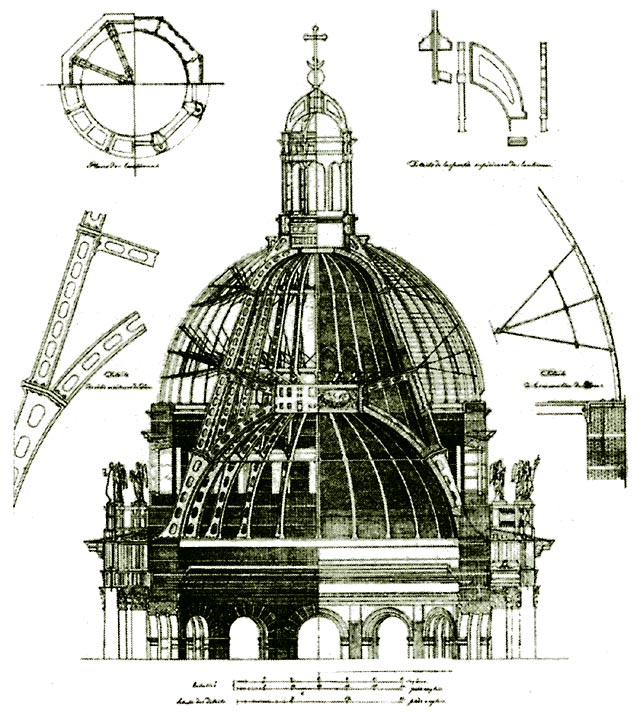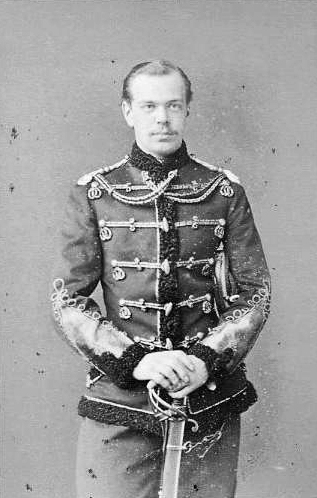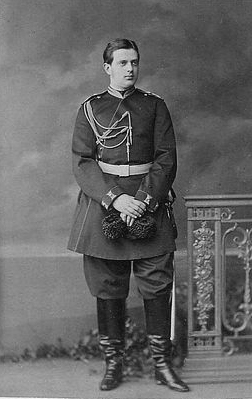|
Maximilian Messmacher
Maximilian (von) Messmacher (russian: Максимилиан Егорович Месмахер, ''Maximilian Yegorovich Messmacher''; 1842–1906) was a Russian architect of German ancestry. He attended the School of Painting of St. Petersburg Society for the Encouragement of Arts and thereafter the Imperial Academy of Arts, graduating in 1866. He was Professor of artistic and industrial painting as well as the history of decorative styles. He also developed a coherent system of academic training in arts. His main activities are however related to architecture and interior decoration. He engaged in the architecture and interior decoration of palaces of the members of the imperial family and of the mansions of aristocrats, as well as of several churches. Biography Messmacher was born in Saint Petersburg in 1842. He attended a high school in Saint Petersburg from 1850 to 1857 and thereafter the School of Painting of St. Petersburg Society for the Encouragement of Arts. Finally, ... [...More Info...] [...Related Items...] OR: [Wikipedia] [Google] [Baidu] |
Saint Petersburg
Saint Petersburg ( rus, links=no, Санкт-Петербург, a=Ru-Sankt Peterburg Leningrad Petrograd Piter.ogg, r=Sankt-Peterburg, p=ˈsankt pʲɪtʲɪrˈburk), formerly known as Petrograd (1914–1924) and later Leningrad (1924–1991), is the second-largest city in Russia. It is situated on the Neva River, at the head of the Gulf of Finland on the Baltic Sea, with a population of roughly 5.4 million residents. Saint Petersburg is the fourth-most populous city in Europe after Istanbul, Moscow and London, the most populous city on the Baltic Sea, and the world's northernmost city of more than 1 million residents. As Russia's Imperial capital, and a historically strategic port, it is governed as a federal city. The city was founded by Tsar Peter the Great on 27 May 1703 on the site of a captured Swedish fortress, and was named after apostle Saint Peter. In Russia, Saint Petersburg is historically and culturally associated with t ... [...More Info...] [...Related Items...] OR: [Wikipedia] [Google] [Baidu] |
Façade
A façade () (also written facade) is generally the front part or exterior of a building. It is a Loanword, loan word from the French language, French (), which means 'frontage' or 'face'. In architecture, the façade of a building is often the most important aspect from a design standpoint, as it sets the tone for the rest of the building. From the engineering perspective, the façade is also of great importance due to its impact on Efficient energy use, energy efficiency. For historical façades, many local zoning regulations or other laws greatly restrict or even forbid their alteration. Etymology The word is a loanword from the French , which in turn comes from the Italian language, Italian , from meaning 'face', ultimately from post-classical Latin . The earliest usage recorded by the ''Oxford English Dictionary'' is 1656. Façades added to earlier buildings It was quite common in the Georgian architecture, Georgian period for existing houses in English towns to be give ... [...More Info...] [...Related Items...] OR: [Wikipedia] [Google] [Baidu] |
Germany
Germany,, officially the Federal Republic of Germany, is a country in Central Europe. It is the second most populous country in Europe after Russia, and the most populous member state of the European Union. Germany is situated between the Baltic and North seas to the north, and the Alps to the south; it covers an area of , with a population of almost 84 million within its 16 constituent states. Germany borders Denmark to the north, Poland and the Czech Republic to the east, Austria and Switzerland to the south, and France, Luxembourg, Belgium, and the Netherlands to the west. The nation's capital and most populous city is Berlin and its financial centre is Frankfurt; the largest urban area is the Ruhr. Various Germanic tribes have inhabited the northern parts of modern Germany since classical antiquity. A region named Germania was documented before AD 100. In 962, the Kingdom of Germany formed the bulk of the Holy Roman Empire. During the 16th ce ... [...More Info...] [...Related Items...] OR: [Wikipedia] [Google] [Baidu] |
Saint Isaac's Cathedral
Saint Isaac's Cathedral or Isaakievskiy Sobor (russian: Исаа́киевский Собо́р) is a large architectural landmark cathedral that currently functions as a museum with occasional church services in Saint Petersburg, Russia. It is dedicated to Saint Isaac of Dalmatia, a patron saint of Peter the Great, who had been born on the feast day of that saint. It was originally built as a cathedral but was turned into a museum by the Soviet government in 1931 and has remained a museum ever since, with church services held in a side chapel since the 1990's. In 2017, the Governor of Saint Petersburg offered to transfer the cathedral back to the Russian Orthodox Church, but this was not accomplished due to the protests of St Petersburg citizens opposing the offer. History The church on St Isaac's Square was ordered by Tsar Alexander I, to replace an earlier structure by Vincenzo Brenna, and was the fourth consecutive church standing at this place. A specially appointed com ... [...More Info...] [...Related Items...] OR: [Wikipedia] [Google] [Baidu] |
Crimea
Crimea, crh, Къырым, Qırım, grc, Κιμμερία / Ταυρική, translit=Kimmería / Taurikḗ ( ) is a peninsula in Ukraine, on the northern coast of the Black Sea, that has been occupied by Russia since 2014. It has a population of 2.4 million. The peninsula is almost entirely surrounded by the Black Sea and the smaller Sea of Azov. The Isthmus of Perekop connects the peninsula to Kherson Oblast in mainland Ukraine. To the east, the Crimean Bridge, constructed in 2018, spans the Strait of Kerch, linking the peninsula with Krasnodar Krai in Russia. The Arabat Spit, located to the northeast, is a narrow strip of land that separates the Sivash lagoons from the Sea of Azov. Across the Black Sea to the west lies Romania and to the south is Turkey. Crimea (called the Tauric Peninsula until the early modern period) has historically been at the boundary between the classical world and the steppe. Greeks colonized its southern fringe and were absorbed by the Ro ... [...More Info...] [...Related Items...] OR: [Wikipedia] [Google] [Baidu] |
Massandra
Massandra or Masandra ( crh, Massandra; russian: Массандра; uk, Масандра) is an urban-type settlement in the Yalta Municipality in Crimea. Occupying the spot of an ancient Greek settlement (Tavrida-Ταυρίδα), Masandra was acquired by Counts Potocki in 1783. In the mid-19th century, it passed to Prince Vorontsov Jr, whose father was the governor of New Russia. Enraptured by a picturesque setting, Vorontsov in 1881 engaged a team of French architects to design for him a château in the Louis XIII style. He died the following year and construction work was suspended until 1889, when the messuage was purchased by Alexander III of Russia. The tsar asked architect Maximilian Messmacher to finish the palace for his own use but he did not live to see it completed in 1900. During the Soviet years, the palace was employed by Joseph Stalin as his dacha. Today, Masandra is known for its viniculture and production of dessert and fortified wines. The Massandra Winery ... [...More Info...] [...Related Items...] OR: [Wikipedia] [Google] [Baidu] |
Alexander III Of Russia
Alexander III ( rus, Алекса́ндр III Алекса́ндрович, r=Aleksandr III Aleksandrovich; 10 March 18451 November 1894) was Emperor of Russia, King of Poland and Grand Duke of Finland from 13 March 1881 until his death in 1894. He was highly reactionary and reversed some of the liberal reforms of his father, Alexander II. This policy is known in Russia as "counter-reforms" ( rus, контрреформы). Under the influence of Konstantin Pobedonostsev (1827–1907), he opposed any reform that limited his autocratic rule. During his reign, Russia fought no major wars; he was therefore styled "The Peacemaker" ( rus, Миротворец, Mirotvorets, p=mʲɪrɐˈtvorʲɪt͡s). It was he who helped forge the Russo-French Alliance. Personality Grand Duke Alexander Alexandrovich was born on 10 March 1845 at the Winter Palace in Saint Petersburg, Russian Empire, the second son and third child of Tsesarevich Alexander (Future Alexander II) and his first wife ... [...More Info...] [...Related Items...] OR: [Wikipedia] [Google] [Baidu] |
Anichkov Palace
The Anichkov Palace, a former imperial palace in Saint Petersburg, stands at the intersection of Nevsky Avenue and the Fontanka River. History 18th century The palace, situated on the plot formerly owned by Antonio de Vieira (1682?-1745), takes its name from the nearby Anichkov Bridge across the Fontanka. Designed for the Empress Elizabeth of Russia () in a dazzling Baroque style, the palace came to be known as the most imposing private residence of the era of Elizabeth Petrovna. Some suggest architects Bartolomeo Rastrelli and Mikhail Zemtsov were responsible for the design, though that is yet to be substantiated. The main frontage faces the river and was originally connected to it by a canal Canals or artificial waterways are waterways or engineered channels built for drainage management (e.g. flood control and irrigation) or for conveyancing water transport vehicles (e.g. water taxi). They carry free, calm surface flow un .... Construction works continued fo ... [...More Info...] [...Related Items...] OR: [Wikipedia] [Google] [Baidu] |
Grand Duke Paul Alexandrovich Of Russia
Grand Duke Paul Alexandrovich of Russia (russian: Павел Александрович; 3 October 1860 – 28 January 1919) was the sixth son and youngest child of Emperor Alexander II of Russia by his first wife, Empress Maria Alexandrovna. He was a brother of Emperor Alexander III and uncle of Nicholas II, Russia's last monarch. He entered the Russian Army, was a general in the Cavalry and adjutant general to his brother Emperor Alexander III, and a Knight of the Order of St. Andrew. In 1889, he married Princess Alexandra of Greece, his paternal first cousin once removed. The couple had a daughter and a son, but Alexandra died after the birth of their second child. In his widowhood, Grand Duke Paul began a relationship with Olga Valerianovna Karnovich, a married woman with three children. After obtaining a divorce for Olga and in defiance of strong family opposition, Grand Duke Paul married her in October 1902. As he contracted a morganatic marriage with a divorcée in ... [...More Info...] [...Related Items...] OR: [Wikipedia] [Google] [Baidu] |
Grand Duke Vladimir Alexandrovich Of Russia
Grand Duke Vladimir Alexandrovich of Russia (russian: Влади́мир Александрович; 22 April 1847 – 17 February 1909) was a son of Emperor Alexander II of Russia, a brother of Emperor Alexander III of Russia and the senior Grand Duke of the House of Romanov during the reign of his nephew, Emperor Nicholas II. Grand Duke Vladimir followed a military career and occupied important military positions during the reigns of the last three Russian Emperors. Interested in artistic and intellectual pursuits; he was appointed President of the Academy of Fine Arts. He functioned as a patron of many artists and as a sponsor of the Imperial ballet.Perry & Pleshakov, ''The Flight of the Romanovs '', p. 35 During the reign of his father, Emperor Alexander II, he was made Adjutant-General, senator in 1868 and a member of the Council of State in 1872. His brother, Alexander III, also promoted his career. He became a member of the Council of Ministers, Commander of the Imperial ... [...More Info...] [...Related Items...] OR: [Wikipedia] [Google] [Baidu] |
Grand Duke Michael Mikhailovich Of Russia
Grand Duke Michael Mikhailovich of Russia (Russian: Михаил Михайлович; 16 October 1861 – 26 April 1929) was a son of Grand Duke Michael Nicolaievich of Russia and a grandson of Tsar Nicholas I of Russia. He was raised in the Caucasus, where he lived between 1862 and 1881 with his family, and was educated by private tutors. As Romanov tradition demanded, he followed a military career. He served in the Russo-Turkish War in 1877, became a Colonel and was adjutant at the Imperial court. In 1891 he contracted a morganatic marriage with Countess Sophie von Merenberg, a morganatic daughter of Prince Nicholas William of Nassau and a granddaughter of the Russian poet Alexander Pushkin. For contracting this marriage without permission, Emperor Alexander III of Russia stripped him of his military titles and banished the couple from the Russian Empire. For some years he lived in Wiesbaden, Nassau and in Cannes. He settled permanently in England in 1900, leasing Keele Ha ... [...More Info...] [...Related Items...] OR: [Wikipedia] [Google] [Baidu] |

.jpg)





